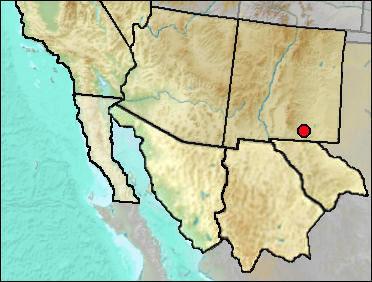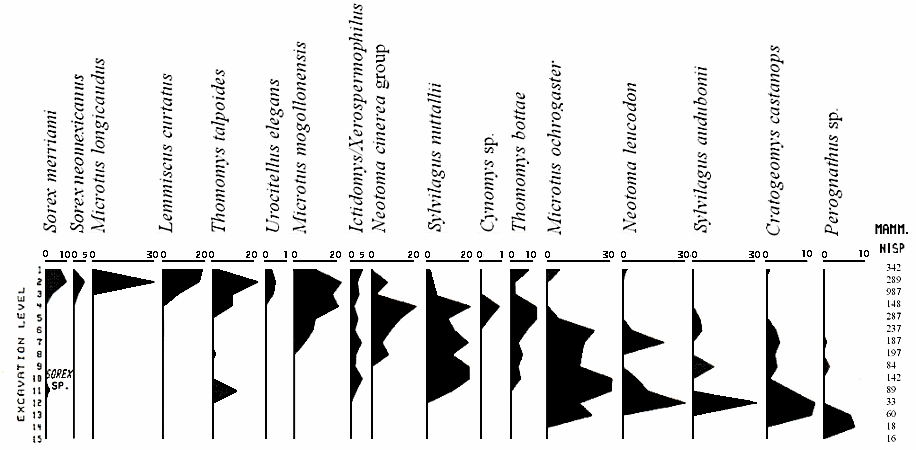 Age. There is a 14C date 15,030
± 210 (I-6201) on bone collagen from Charlies Parlor at a level slightly above
the point at which the wall of the fissure blocks further flow into Animal Fair. This
date may be (as so often is the case with bone dates) somewhat too young (Harris (1989)
estimated Animal Fair grids A and B, Levels 1 - 4, represented full-glacial conditions
of about 18,000-20,000 BP on the basis of relationship to the Charlies Parlor date and
faunal characteristics. Deposits to north and at greater depths are older, probably
approaching or in the mid-Wisconsin at oldest deposits (lower levels of Grid F).
Age. There is a 14C date 15,030
± 210 (I-6201) on bone collagen from Charlies Parlor at a level slightly above
the point at which the wall of the fissure blocks further flow into Animal Fair. This
date may be (as so often is the case with bone dates) somewhat too young (Harris (1989)
estimated Animal Fair grids A and B, Levels 1 - 4, represented full-glacial conditions
of about 18,000-20,000 BP on the basis of relationship to the Charlies Parlor date and
faunal characteristics. Deposits to north and at greater depths are older, probably
approaching or in the mid-Wisconsin at oldest deposits (lower levels of Grid F).
General Description. Includes all areas placed under UTEP Loc. 22: Animal Fair, Charlies Parlor, Hampton Court, and NW Talus Slope. The only date available is that mentioned above from lower part of Charlies Parlor (just above level of A8 L1)
Discussion. The Animal Fair Room site was originally gridded with 32-ft grids, A through F from south to north and 1 to 8 (later 9 or 10 at the south end) from east to west. Grids were excavated in 10-cm levels. Animal Fair deposits spilled from the vertical Entrance Fissure, with some water deposition at lower levels (apparent in lower levels of grids farthest from the fissure). Some additional collections were made later without reference to the grid system.
Harris (1993a) described the stratification of Animal Fair as revealed in the D grid. Sterile cave debris was followed by silty clays (Stratum 4) deposited some 6 m east of the source fissure. Stratum 3 consists of gravelly, fossiliferous fill near the fissure with sandy silt to the east; over much of the area of contact, the line of demarcation is sharp, and the sandy silt is believed to have resulted from fines washed from the gravelly areas during deposition. Stratum 2 consists of gravelly matrix with large rocks near the fissure , but grades into a dark brown silty clay to the east; megafaunal remains are common. Faunal analysis indicates the transition from Stratum 3 to 2 occurred at the changeover from mid-Wisconsin to late-Wisconsin climatic conditions. Stratum 1 consists of light, powdery sediments, some of which, in the eastern part of the sediments, have filled desiccation cracks into Stratum 2 and, occasionally, into the upper parts of Stratum 3.
Charlies Parlor lies in the Entrance Fissure itself, and was originally accessed by a tunnel dug from Animal Room. The upper deposits share some individuals with UTEP 31 (e.g., bones of what almost certainly is one individual of Equus occidentalis occur in both); Animal Fair Room lies east of the fissure and Hampton Court to the west (the fissure is the source of the material in both cases. At one time during excavation, a short tunnel connected Animal Fair and Hampton Court, but was little used because of the danger of collapse. Most material from Hampton Court appears to be the equivalent of the older, northern portion of Animal Fair.
Applegarth (1979) looked extensively at amphibian and reptile remains from grids A7 and A8, but also noted in passing several taxa from other parts of the grid; the latter are noted with a parenthetical grid row (e.g., "F"); all other records of Applegarth are from the full-glacial A7 and A8. Noting that the younger (A Grid) herpetofauna was quite different from the older material (F Grid), Applegarth (1979: 34) contrasted samples from those grids:
A sample from the A end (A8L2) is 22% amphibian by weight (11 g versus 39 g of reptile) and a sample from the other end (F2L5) is only 12% amphibian (4¼ g versus 31 g). The sample from the A end includes 16 items of Pseudacris but only one of small Plestiodon and two of Crotaphytus collaris. In contrast, the sample from the F end of the grid apparently contains no Pseudacris but does contain 18+ items of small Plestiodon, 140+ items of Crotaphytus (most appear identifiable to C. collaris), and 12+ items of Callisaurus [Cophosaurus] (several maxillae and a quadrate seem to represent C. maculatus [Holbrookia maculata]). Callisaurus is not represented in the samples from the A end of the grid.
The A Grid, then, obviously records a cooler, more mesic herpetofauna than that of the older deposits, which I interpret as Mid-Wisconsin in age. The sequence from more to less glacial climate also can be seen in the mammalian fauna (Fig. 1).

Fig. 1. Percentages of selected mammalian taxa calculated for each of the 15 excavation levels of Grid D7. Note that percentage scales vary among taxa. MAMM. NISP, number of identified mammalian specimens. After Harris (1993a).
Figure 1 shows the relative frequencies of 17 mammalian taxa in a 1.5-m mid to late Wisconsin section from Animal Fair (Harris 1993a). Taxa typical of cooler and moister conditions are on the left and those more typical of warmer and drier conditions to the right. The lower levels appear to indicate semi-arid, relatively warm grasslands or grassy woodlands that are replaced up-section by cool, relatively dense vegetation that included sagebrush, grasses, and mixed coniferous forest elements.
Fauna.
The list of taxa in the table below is of all taxa recognized from UTEP Loc. 22. Taxon accounts give further information as to chronologic distribution.
Osteichthyes—Bony Fishes
Ambystoma mavortium—Barred Tiger Salamander
Scaphiopus couchii—Couch's Spadefoot ("F")
Spea bombifrons—Plains Spadefoot ("D")
Spea multiplicata—New Mexico Spadefoot
Anaxyrus cognatus—Great Plains Toad
Anaxyrus woodhousii—Woodhouse's Toad
Pseudacris triseriata—Western Chorus Frog
Lithobates pipiens—Northern Leopard Frog
Crotaphytus collaris—Eastern Collared Lizard
Holbrookia maculata—Lesser Earless Lizard ("F")
Phrynosoma hernandesi—Mountain Short-horned Lizard
Sceloporus cowlesi—Southern Plateau Lizard
Plestiodon multivirgatus—Many-lined Skink
Bogertophis subocularis—Trans-Pecos Rat Snake
Coluber/Masticophis—Racers and Whip Snakes
Pituophis catenifer—Gopher Snake
Salvadora sp.—Patchnose Snakes
Crotalus sp.—Rattlesnakes
Thamnophis sp.—Garter Snakes
Anas cyanoptera—Cinnamon Teal (?)
Teratornis merriami—Merriam's Teratorn REJECTED
†Coragyps occidentalis—Western Vulture
Tympanuchus pallidicinctus—Lesser Prairie-Chicken
Accipiter cooperii—Cooper's Hawk
Aquila chrysaetos—Golden Eagle
Buteo jamaicensis—Red-tailed Hawk (cf.)
Buteogallus anthracinus—Common Black Hawk (?)
Circus cyaneus—Northern Harrier
Caracara cheriway—Crested Caracara
Falco mexicanus—Prairie Falcon
Falco sparverius—American Kestrel
Fulica americana—American Coot
Limnodromus scolopaceus—Long-billed Dowitcher
Numenius americanus—Long-billed Curlew
Tringa melanoleuca—Greater Yellowlegs
Tringa semipalmata—Willet (?)
Zenaida macroura—Mourning Dove
Asio flammeus—Short-eared Owl (cf. gen. et sp.)
Bubo virginianus—Great Horned Owl
Megascops/Otus —Screech/Flammulated Owls (?)
Colaptes auratus—Northern Flicker
Petrochelidon fulva/pyrrhonota—Cliff/Cave Swallow (cf.)
Corvus corax—Common Raven
Pica hudsonia—Black-billed Magpie
Xanthocephalus xanthocephalus—Yellow-headed Blackbird
Nothrotheriops shastensis—Shasta Ground Sloth
Cynomys gunnisoni—Gunnison's Prairie Dog
Ictidomys tridecemlineatus—Thirteen-lined Ground Squirrel
Marmota flaviventris—Yellow-bellied Marmot
Urocitellus elegans—Wyoming Ground Squirrel
Dipodomys ordii—Ord's Kangaroo Rat (cf.)
Dipodomys spectabilis—Banner-tailed Kangaroo Rat
Perognathus (Perognathus) sp.—Silky Pocket Mice
Perognathus Species A—Unidentified Pocket Mouse
Cratogeomys castanops—Yellow-faced Pocket Gopher
Thomomys bottae—Botta's Pocket Gopher
Thomomys talpoides—Northern Pocket Gopher
Lemmiscus curtatus—Sagebrush Vole
Microtus longicaudus—Long-tailed Vole
Microtus mogollonensis—Mogollon Vole
Microtus ochrogaster—Prairie Vole
Microtus pennsylvanicus—Meadow Vole
Ondatra zibethicus—Common Muskrat
Neotoma cinerea—Bushy-tailed Woodrat
Neotoma goldmani—Goldman's Woodrat (?)
Neotoma leucodon—White-toothed Woodrat
Neotoma mexicana—Mexican Woodrat
Onychomys leucogaster—Northern Grasshopper Mouse
Peromyscus boylii—Brush Mouse (cf.)
Peromyscus leucopus—White-footed Mouse
Reithrodontomys—Harvest Mice
Erethizon dorsata—American Porcupine
Lepus californicus—Black-tailed Jackrabbit
Lepus townsendii—White-tailed Jackrabbit
Sylvilagus audubonii—Desert Cottontail
Sylvilagus nuttallii—Mountain Cottontail
Cryptotis parva—Least Shrew
Sorex merriami—Merriam's Shrew
Sorex neomexicanus—New Mexican Shrew
Sorex preblei—Preble's Shrew
Corynorhinus townsendii—Townsend's Big-eared Bat
Eptesicus fuscus—Big Brown Bat
Myotis californicus/ciliolabrum—California Myotis/Western Small-footed
Myotis
Myotis velifer— Cave Myotis
Lynx rufus—Bobcat
Puma concolor—Mountain Lion (cf.)
Canis latrans—Coyote
Canis lupus—Gray Wolf (cf.)
Vulpes macrotis—Kit Fox
Vulpes velox—Swift Fox
Ursus sp.—Bear (cf.)
Mustela frenata—Long-tailed Weasel
Mephitis mephitis—Striped Skunk
Spilogale sp.—Spotted Skunk
Bassariscus astutus—Ringtail
†Equus conversidens—Western Horse
†Equus scotti—Scott's Horse
†Equus occidentalis—Western Horse (cf.) (This volume)
†Camelops—American Camel (cf.)
†Hemiauchenia macrocephala—Big-headed Llama
Odocoileus hemionus—Mule Deer (cf.)
Antilocapra americana—Pronghorn
†Capromeryx—Miniature Pronghorns
†Stockoceros conklingi—Conkling's Pronghorn
Ovis canadensis—Bighorn Sheep
Literature. Applegarth, 1979; Buckley 1973; Harris 1977, 1985a, 1989, 1993a; Harris and Mundel 1974; Harris and Porter 1980; Magish and Harris 1976.
Last Update: 19 Feb 2015